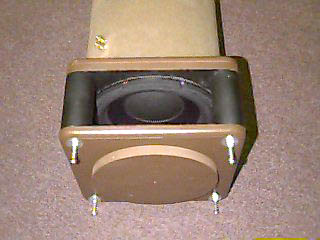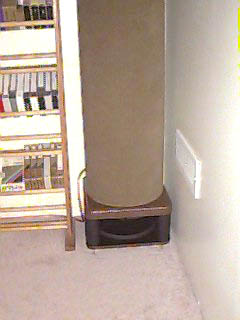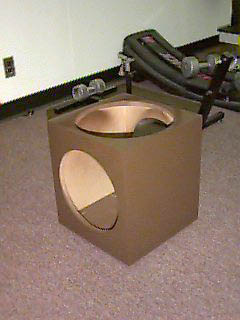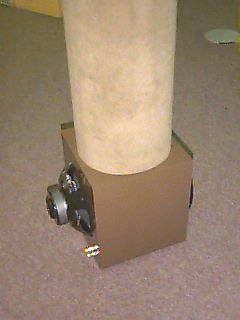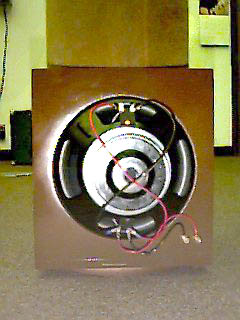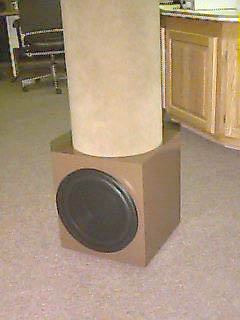| Steve's Compounded,
Super-Duper Shiva/Sonotube(R) T-line Subwoofers
by Steve Zettel
|
||||
|
|
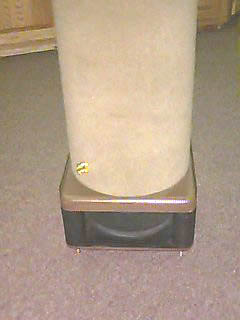 |
|
||
| The subwoofers were crossed
over to the main speakers using a Shadow LE crossover kit designed by Neil Shattles
and originally marketed by Audio Concepts, Inc. I chose 45 Hz as the upper knee since
my Magnepan 1.6 QR's start rolling off at about 40 Hz. Motivating power was provided
by a venerable brute, a Bedini 200 wpc solid-state amplifier. Those who remember
Bedini as a player in the high-end market of the early '80's might also remember
that John Bedini would demonstrate the current-capability of his amps into low impedance
loads by hooking a signal generator to the input and then arc-welding with them! Initial tuning was done with an audio frequency generator and 'scope donated by friend Bob Berkman, a Radio Shack SPL meter, and a CD of test tones. Fine tuning was done by ear, using a variety of CD and vinyl sources. |
|
|||
|
Take 2 This might have been the happy ending to the story, if I hadn't seen a posting from an acquaintance advertising a pair of Shiva drivers for sale to help finance a home remodeling project. Power corrupts, and absolute power corrupts absolutely! The price was too good to pass up, even if I didn't immediately have an application in mind. My wife had tolerated the introduction of the Shiva/Sonotube(R) subwoofers into the house, but four of the tall pipes would be out of the question! So some way to utilize two Shivas per side had to be developed. This really wasn't too long after the completion of the original Shiva/Sonotube(R)s, and I was reluctant to dismantle my creations to fabricate new enclosures. After a bit of thought, it dawned on me that it would be simple enough to mount another driver in the open end of the transmission line, converting it from a one-driver t-line to a two-driver sealed "box". |
||||
| A quick calculation and
reference to the Adire Audio literature showed that the resulting volume of about
3.0 cubic feet per driver would be a medium-low Q enclosure, and should be a decent
solution. In a word, NOT! Whether it was the fault of the Sonotube(R), rigid enough for t-line applications but too flexy for sealed-box enclosures, or just the comparison of transmission line sonic qualities to acoustic suspension, I don't know. But subjectively, though there was an increase in the quantity of low bass, the quality of what was present was degraded. Muddiness, bloat, and a subjective sense of slowness replaced the t-line's clarity, articulate presentation, and seamless integration with the main planar speakers. This just wouldn't do. |
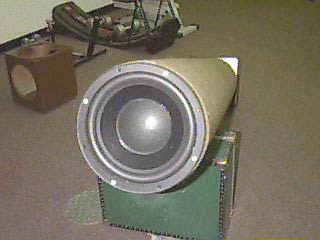 |
|||
| I ended up doing what
I knew I should have done all along. A serendipitous bit of cross-pollenization had occurred in a conversation with friend Chris Brady earlier in the spring -- he had acquired four bass drivers and was planning to integrate them in his system as subwoofers, I had already done this with two drivers in the initial Shiva/Sonotube(R) t-line project. I planted the germ of using a tubular transmission line enclosure with him, and came away with the idea of compounding two drivers per side by mounting them into the same enclosure, one facing out and the other facing in, wired out-of-phase so that one pushes while the other pulls. The theoretical advantages of cancelling driver non-linearities as well as minimizing vibrational stress on the enclosure in at least one plane was very attractive. |
||||
|
I fabricated a pair of simple 14" square boxes from 3/4" MDF, screwed, glued and caulked, with a removable bottom panel, and holes routed in front, back and top for the two drivers and the Sonotube(R) t-line.
|
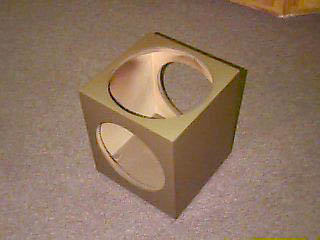 |
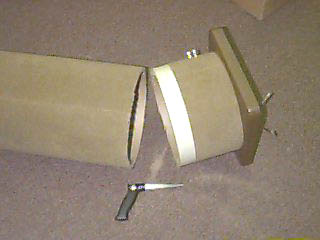 |
||
| Drivers were removed from both ends of the Sonotube(R), and a quick "basectomy" was performed to allow recycling of the carpet-covered Sonotube(R). Wide masking tape served as a cutting guide in the picture. | The liberated Sonotube(R), now restored to a transmission line, is mated with the new driver enclosure -- screws, glue and sealant provide the adhesion and air-tight seal. | |||
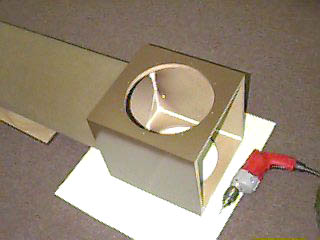 Drivers were mounted next. Each driver was strapped for parallel voice coil operation. Note that this results in a final 2-ohm configuration when the two drivers are paralleled together, requiring an amplifier up to the task. The trusty Bedini makes light work of this load, but be careful not to overstress your amp. Alternatively, each driver could have it's voice coils wired in series before being parallelled, resulting in an 8-ohm load, though at some loss in efficiency. |
|
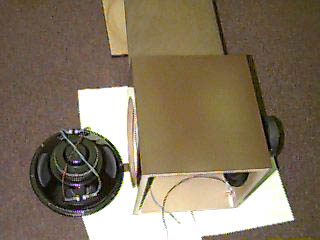 Final connections are made inside the box, stuffing is replaced in the box and line, and the base of the enclosure is sealed and screwed in place. Note that the driver on the rear of the enclosure is connected to the binding posts out-of-phase, resulting in cone movement back, or "out of the box" when the front speaker cone moves forward, "out of the box". |
||
|
|
The finished product? Gone is the muddiness and heavy quality of the sealed enclosure bass. Restored is the subjective speed, detail and clarity of the transmission line, enhanced by the cancellation of non-linear driver movement. Delicate tympani taps are rendered with realistic low-level detail, the lowest octaves of the piano have greater authority and body, bass drum hits create a palpable pressure-wave, and the lowest stops of the pipe organ are terrifying in their power and majesty. Yet there is never a sense of too much bass when it is not called for, no chestiness of male voices, or over-ripeness of the upper- or mid-bass. Overall, there is a sense of effortlessness, ease and realism that sounds perfectly natural and almost tactile in it's immediacy. Now if I could only find a deal on four more Shivas -- there are, after all, two unused sides left on each enclosure! |
|
||
|
Steve Zettel Rancho De Luxe near Libby, MT USA |
||||
|
[ <-- Back to TL Page | Projects | Steve's PP Shiva ] |
||||

